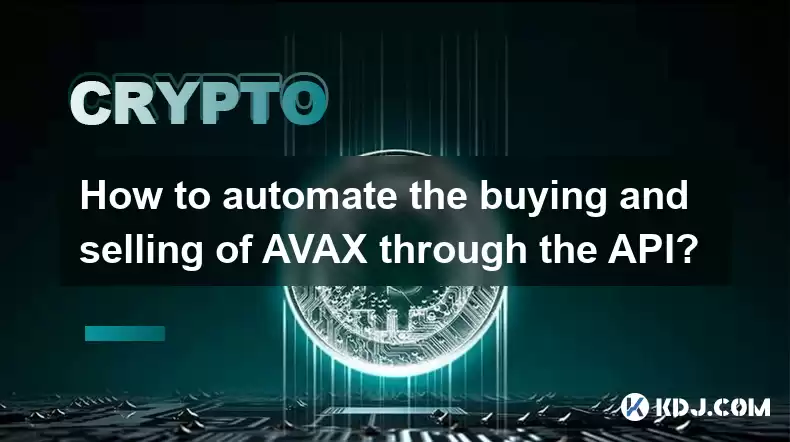-
 bitcoin
bitcoin $87959.907984 USD
1.34% -
 ethereum
ethereum $2920.497338 USD
3.04% -
 tether
tether $0.999775 USD
0.00% -
 xrp
xrp $2.237324 USD
8.12% -
 bnb
bnb $860.243768 USD
0.90% -
 solana
solana $138.089498 USD
5.43% -
 usd-coin
usd-coin $0.999807 USD
0.01% -
 tron
tron $0.272801 USD
-1.53% -
 dogecoin
dogecoin $0.150904 USD
2.96% -
 cardano
cardano $0.421635 USD
1.97% -
 hyperliquid
hyperliquid $32.152445 USD
2.23% -
 bitcoin-cash
bitcoin-cash $533.301069 USD
-1.94% -
 chainlink
chainlink $12.953417 USD
2.68% -
 unus-sed-leo
unus-sed-leo $9.535951 USD
0.73% -
 zcash
zcash $521.483386 USD
-2.87%
How to automate the buying and selling of AVAX through the API?
Automate AVAX trading using APIs from exchanges like Binance or Kraken, setting up scripts with Python and ccxt to buy below $30 and sell above $35.
Apr 21, 2025 at 02:56 pm

Automating the buying and selling of cryptocurrencies like AVAX can streamline your trading process, allowing you to execute trades based on pre-set conditions without manual intervention. This guide will walk you through the steps needed to set up an automated trading system for AVAX using an API.
Choosing the Right Exchange and API
To automate AVAX trades, you'll need to select an exchange that supports AVAX trading and offers a robust API. Popular exchanges like Binance, Coinbase Pro, and Kraken are suitable options. Each exchange has its own API documentation, so it's important to choose one that aligns with your trading needs.
- Binance: Known for its extensive trading pairs and high liquidity, Binance offers a comprehensive API that supports both spot and futures trading.
- Coinbase Pro: Offers a user-friendly API with good documentation, suitable for beginners.
- Kraken: Known for its security and support for a wide range of cryptocurrencies, including AVAX.
Once you've chosen an exchange, you'll need to register for an API key. This key will allow your trading bot to interact with the exchange on your behalf.
Setting Up Your API Key
To set up your API key, follow these steps:
- Log into your exchange account and navigate to the API section.
- Generate a new API key. You'll typically be asked to provide a name for the key and set permissions. For trading AVAX, you'll need to enable permissions for trading and account balance access.
- Save your API key and secret. These will be used in your trading script to authenticate your requests.
Choosing a Programming Language and Library
Next, you'll need to choose a programming language and a library to interact with the API. Python is a popular choice due to its simplicity and the availability of libraries like ccxt and Binance API.
- ccxt: A JavaScript / Python / PHP library for cryptocurrency trading and e-commerce with support for many bitcoin/ether/altcoin exchange markets and merchant APIs.
- Binance API: A Python library specifically designed for interacting with the Binance API.
For this example, we'll use Python and the ccxt library.
Writing the Trading Script
Now, let's write a basic trading script to automate the buying and selling of AVAX. This script will use a simple strategy: buy AVAX when its price drops below a certain threshold and sell when it rises above another threshold.
Here's a sample script using ccxt:
import ccxt
Initialize the exchange
exchange = ccxt.binance({
'apiKey': 'YOUR_API_KEY',
'secret': 'YOUR_SECRET_KEY',
})
Define trading parameters
buy_threshold = 30 # Buy when AVAX price drops below $30sell_threshold = 35 # Sell when AVAX price rises above $35
while True:
# Fetch the current AVAX/USDT price
ticker = exchange.fetch_ticker('AVAX/USDT')
current_price = ticker['last']
# Check if the current price meets our buy condition
if current_price sell_threshold:
# Place a market sell order for 1 AVAX
order = exchange.create_market_sell_order('AVAX/USDT', 1)
print(f'Sold 1 AVAX at {current_price}')
# Wait for a short period before checking again
time.sleep(60) # Wait for 1 minute
This script will continuously monitor the AVAX price and execute trades based on the defined thresholds.
Implementing Risk Management
To ensure your trading strategy is sustainable, it's crucial to implement risk management techniques. Here are some key considerations:
- Stop-Loss Orders: Set a stop-loss order to automatically sell AVAX if its price drops below a certain level, limiting potential losses.
- Take-Profit Orders: Set a take-profit order to automatically sell AVAX if its price rises above a certain level, locking in profits.
- Position Sizing: Determine the size of your trades based on your total capital to manage risk effectively.
Here's how you can modify the script to include a stop-loss:
import ccxt
exchange = ccxt.binance({
'apiKey': 'YOUR_API_KEY',
'secret': 'YOUR_SECRET_KEY',
})
buy_threshold = 30sell_threshold = 35stop_loss = 28 # Stop-loss at $28
while True:
ticker = exchange.fetch_ticker('AVAX/USDT')
current_price = ticker['last']
if current_price sell_threshold:
order = exchange.create_market_sell_order('AVAX/USDT', 1)
print(f'Sold 1 AVAX at {current_price}')
time.sleep(60)
Testing and Backtesting Your Strategy
Before deploying your trading script in a live environment, it's essential to test and backtest your strategy. Testing helps identify any bugs or errors in your code, while backtesting allows you to evaluate the performance of your strategy using historical data.
- Testing: Run your script in a simulated environment or with a small amount of capital to ensure it functions as expected.
- Backtesting: Use historical price data to simulate how your strategy would have performed in the past. Libraries like
backtrader or zipline can be used for backtesting in Python.
Here's a simple example of how you might backtest your strategy using historical data:
import pandas as pd
import ccxt
exchange = ccxt.binance()ohlcv = exchange.fetch_ohlcv('AVAX/USDT', '1d')
df = pd.DataFrame(ohlcv, columns=['timestamp', 'open', 'high', 'low', 'close', 'volume'])df['timestamp'] = pd.to_datetime(df['timestamp'], unit='ms')
buy_threshold = 30sell_threshold = 35stop_loss = 28
position = 0balance = 1000 # Starting balance in USDTfor index, row in df.iterrows():
current_price = row['close']
if position == 0 and current_price sell_threshold:
position = 0
sell_price = current_price
balance += sell_price
print(f'Sold 1 AVAX at {sell_price}. Balance: {balance}')
elif current_price
print(f'Final balance: {balance}')
Deploying Your Trading Bot
Once you're satisfied with your strategy's performance, you can deploy your trading bot. Consider the following options:
- Local Deployment: Run your script on your local machine. This is suitable for testing but may not be reliable for long-term use due to potential downtime.
- Cloud Deployment: Use cloud services like AWS, Google Cloud, or DigitalOcean to host your trading bot. This ensures your bot runs continuously and can be easily scaled.
To deploy on a cloud service, you'll need to:
- Set up a virtual machine or a container service.
- Install the necessary dependencies, including Python and the
ccxtlibrary. - Upload your trading script and configure it to run automatically.
Here's a basic example of how to set up a cron job on a Linux-based system to run your script every minute:
crontab -eAdd the following line to your crontab file:
* /usr/bin/python3 /path/to/your/script.pyMonitoring and Maintenance
After deploying your trading bot, it's important to monitor its performance and maintain it regularly. Set up alerts to notify you of significant price movements or unexpected behavior. Regularly review your trading logs and adjust your strategy as needed based on market conditions.
Frequently Asked Questions
Q: Can I use the same script to trade other cryptocurrencies?A: Yes, you can modify the script to trade other cryptocurrencies by changing the trading pair in the fetch_ticker and create_order functions. For example, to trade ETH/USDT, you would use 'ETH/USDT' instead of 'AVAX/USDT'.
A: Exchanges have rate limits to prevent abuse. To handle these, you can implement a delay between API calls or use the exchange's built-in rate limit handling features. For example, ccxt has a rateLimit parameter that can be adjusted.
A: Storing API keys directly in your script is not recommended due to security risks. Instead, use environment variables or a secure configuration file to store your keys. This way, your keys are not exposed if your script is shared or compromised.
Q: How can I improve the performance of my trading strategy?A: To improve your strategy, consider incorporating more advanced indicators and technical analysis. You can also use machine learning models to predict price movements and adjust your thresholds dynamically based on market conditions.
Disclaimer:info@kdj.com
The information provided is not trading advice. kdj.com does not assume any responsibility for any investments made based on the information provided in this article. Cryptocurrencies are highly volatile and it is highly recommended that you invest with caution after thorough research!
If you believe that the content used on this website infringes your copyright, please contact us immediately (info@kdj.com) and we will delete it promptly.
- Cardano Price, ADA Pullback, and the Rise of Utility Networks: What's Next?
- 2025-12-07 05:45:01
- LILSHIB Who? Apeing & the Meme Coin Referral Rewards Revolution
- 2025-12-07 05:40:01
- Coinbase's Crypto Comeback Call: Is a December Recovery on the Horizon?
- 2025-12-07 20:05:01
- Bitcoin Price Wobbles: Crypto Market Eyes Recovery, Phong Lee Weighs In
- 2025-12-07 05:25:01
- Coins, Crypto, and Presales: What's Hot in the NYC Crypto Scene?
- 2025-12-07 18:25:01
- Altcoins on the Ropes: Declines and the Great Repricing of '25
- 2025-12-07 05:50:01
Related knowledge

The Ultimate Guide to Navigating Your First Crypto Bull Run
Dec 04,2025 at 02:00pm
Understanding the Crypto Bull Run Cycle1. A bull run in the cryptocurrency market is characterized by a sustained increase in asset prices, often driv...

An Investor's Primer on Bitcoin and Digital Assets
Dec 05,2025 at 07:59pm
Understanding Bitcoin and Its Role in Modern Finance1. Bitcoin emerged in 2009 as the first decentralized digital currency, operating on a peer-to-pee...

The Absolute Beginner's Guide to Reading Crypto Charts
Dec 03,2025 at 06:59pm
Understanding the Basics of Crypto Chart Types1. Line charts are the simplest form of crypto price representation, showing only the closing prices ove...

Your Complete Guide to Crypto Wallets and Security
Dec 03,2025 at 12:00am
Crypto Wallet Types and Their Functions1. Hot wallets are digital wallets connected to the internet, making them convenient for frequent transactions....

The Minimalist's Guide to Getting Started in Crypto
Dec 07,2025 at 08:19am
The Minimalist's Guide to Getting Started in Crypto 1. Understanding the Basics of Cryptocurrency1. Cryptocurrency operates on decentralized networks ...

How to Safely Buy and Store Cryptocurrency: A Beginner's Guide
Dec 07,2025 at 02:00am
Understanding the Basics of Cryptocurrency Purchases1. Choosing a reputable cryptocurrency exchange is essential for new investors. Platforms like Coi...

The Ultimate Guide to Navigating Your First Crypto Bull Run
Dec 04,2025 at 02:00pm
Understanding the Crypto Bull Run Cycle1. A bull run in the cryptocurrency market is characterized by a sustained increase in asset prices, often driv...

An Investor's Primer on Bitcoin and Digital Assets
Dec 05,2025 at 07:59pm
Understanding Bitcoin and Its Role in Modern Finance1. Bitcoin emerged in 2009 as the first decentralized digital currency, operating on a peer-to-pee...

The Absolute Beginner's Guide to Reading Crypto Charts
Dec 03,2025 at 06:59pm
Understanding the Basics of Crypto Chart Types1. Line charts are the simplest form of crypto price representation, showing only the closing prices ove...

Your Complete Guide to Crypto Wallets and Security
Dec 03,2025 at 12:00am
Crypto Wallet Types and Their Functions1. Hot wallets are digital wallets connected to the internet, making them convenient for frequent transactions....

The Minimalist's Guide to Getting Started in Crypto
Dec 07,2025 at 08:19am
The Minimalist's Guide to Getting Started in Crypto 1. Understanding the Basics of Cryptocurrency1. Cryptocurrency operates on decentralized networks ...

How to Safely Buy and Store Cryptocurrency: A Beginner's Guide
Dec 07,2025 at 02:00am
Understanding the Basics of Cryptocurrency Purchases1. Choosing a reputable cryptocurrency exchange is essential for new investors. Platforms like Coi...
See all articles










































































